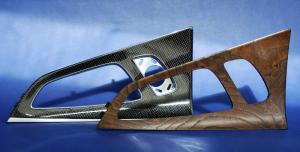Technical Report 2012-10-30
Content shown in the technical articles are the sole opinion and views of the authors or companies, which are not necessarily congruent to opinion and views of the editors.
|
Premium ambience for car interior - injection moulding meets craftsmanship Gabriele Hopf, Wittmann Battenfeld GmbH In the pioneering days of automobile engineering, all vehicles had bodies with wooden frames and wooden dashboards, and they were premium products crafted individually and by hand. Today, the motorcar is a mass product made in different quality categories. But the premium-class models are distinguished from the standard versions by luxury extras, primarily in the interior. These include above all decorative parts with real wood veneer surfaces or carbon fabric with special surface finishes, even going as far as piano lacquer finish. In spite of all mechanization, the production of such parts still requires a high degree of skilled craftsmanship. The market leader in this domain is the German company Novem Car Interior Design GmbH. For the production of these wood/plastic and/or carbon/plastic composite parts, Novem has decided to invest in the new MacroPower injection molding machines from Wittmann Battenfeld. With their ergonomically designed clamping units, these machines offer optimal conditions for an effective combination of machine operation with plastics processing.
 Abb.1: Dekorzierleisten in Echtholz oder Karbongewebe mit Kunststoff-Träger und einer Oberflächenveredelung mit PUR werten den Automobilinnenraum auf.  Abb. 2: Beispiel eines Stylingsets mit Echtholz-Furnieroberflächen im Innenraum eines Premium-Fahrzeugs, bestehend aus Mittelkonsolenblende, Armaturenbrett-Einsätzen und Türgriffblenden. (Foto: Porsche Austria GmbH & Co OG) But premium requires first-class workmanship. In spite of all modern technology, it takes a considerable number of production steps and highly skilled craftsmanship to produce a ready-to-install decorative part from the raw veneer (fig.3). Battenfeld injection molding technology meets craftsmanship Both veneers and fabrics have a life or their own in spite of most meticulous preparation. They are of course stabilized by preparatory steps such as trimming, compression-molding and lamination with liners prior to being processed on an injection molding machine, yet their insertion into the cavity of the mold requires the experience and sensitivity of a machine operator.  Abb.3: Novem-Anwendungstechnikchef Peter Ade demonstriert der Wittmann Battenfeld Kommunikationsleiterin Gabriele Hopf die Ausgangsmaterialien für die Oberflächengestaltung der Dekorsets. Verwendet werden ausschließlich sorgfältig ausgesuchte Edelholz-Furniere oder Kombinationsprodukte daraus. Following an extensive selection process, the actual decision at Novem was made in favor of Wittmann Battenfeld MacroPower 1100 / 3400 machines. With a 1,450 x 1,100 mm distance between tie-bars, the clamping unit of these machines provides the necessary space for insertion and movement. In contrast to the generously dimensioned clamping unit, the smaller 3,400 model with a 65 mm screw was selected as injection unit. This is in keeping with the generally light shot weights of the decorative parts. Model changeover made easy  Abb. 4: Da die Produktionsflächen bei Novem-Slowenien bis ans Limit belegt sind, standen bei der Ersatzinvestition kompakte Maschinenabmessungen ganz oben auf der Spezifikationsliste. Summary Novem’s production is an outstanding example for the significance of an ergonomically designed interface between a machine and its operator. This is how Peter Ade sums up the situation, adding: “After a break of several years, we have become a Battenfeld customer once more, because the new MacroPower machine concept was able to completely fulfill our specific requirements, and with its comparatively compact dimensions helps to keep the requirements for valuable production floor space small, too (fig.5). The actual injection molding performance was not our most important consideration, since it is a given anyway.“ Wittmann Battenfeld Wittmann Battenfeld, a company of the Wittmann group based in Kottingbrunn, Austria is a leading manufacturer of injection molding machines for the plastics industry. With its own sales and service companies as well as representations in about 60 countries, About Novem Novem is a global supplier of high-quality decorative parts and decorative functional elements for automotive interiors. The automotive supplier based in Vorbach/Upper Palatinate, Bavaria is the number one worldwide in the market for decorative parts made of precious wood. In addition to its well-established line of processing precious wood, Novem has established innovative plastics and metal technology and has thus become a full-range supplier. Thanks to its program management, Novem is also able to function as a system supplier of all decorative parts required for automotive interiors. Leading automobile manufacturers and automotive suppliers in the premium segment rely on the excellent design and development performance from Upper Palatinate. The Novem customer base includes all well-known automobile manufacturers. Novem currently employs 4,800 associates at its ten production plants. www.novem.de Wittmann Battenfeld GmbH Wiener Neustädter Straße 81 Phone: +43 2252 404-0 Internet: www.wittmann-group.com |
 back to the list back to the list |  back to top back to top |



